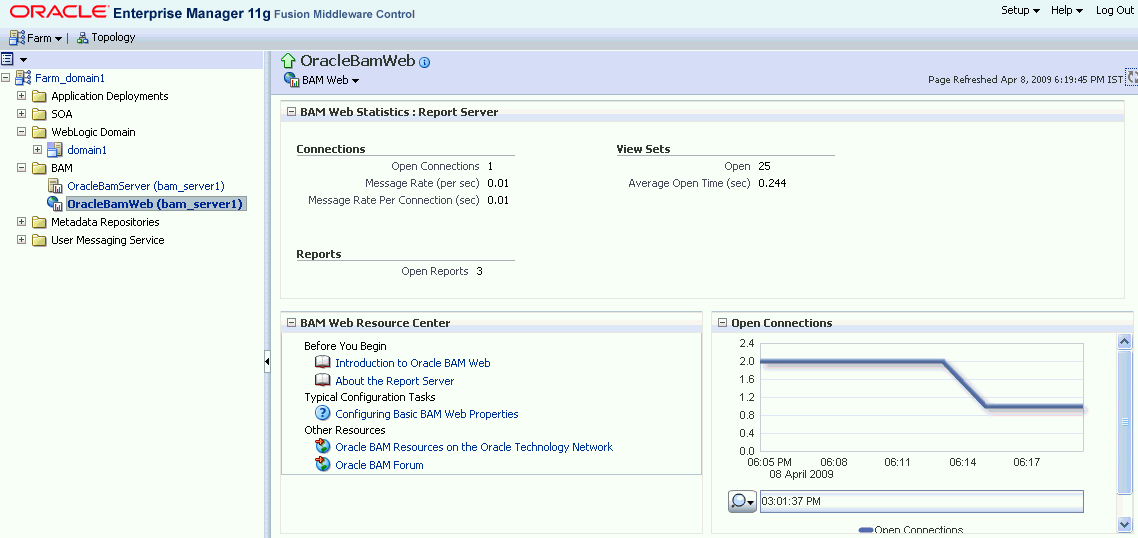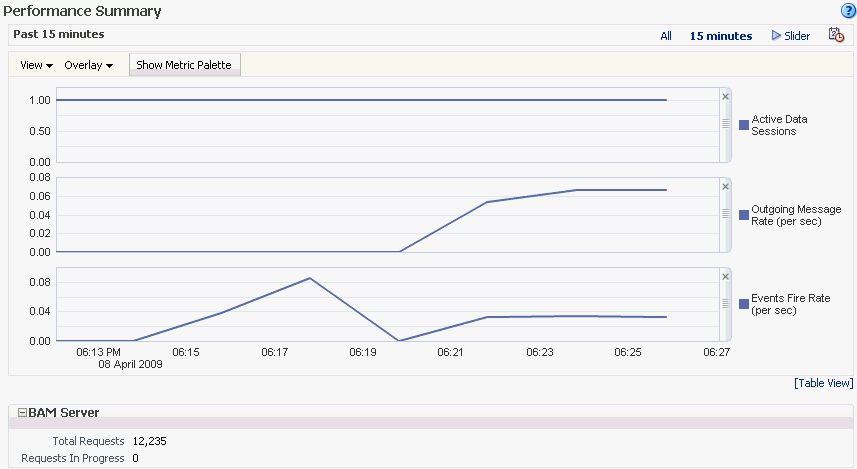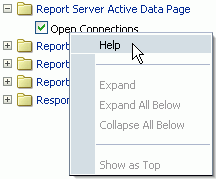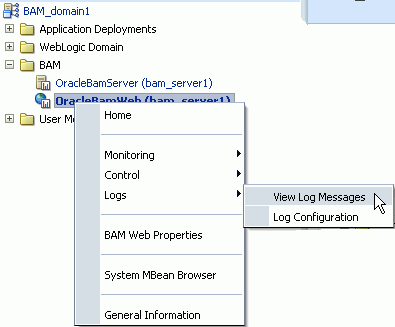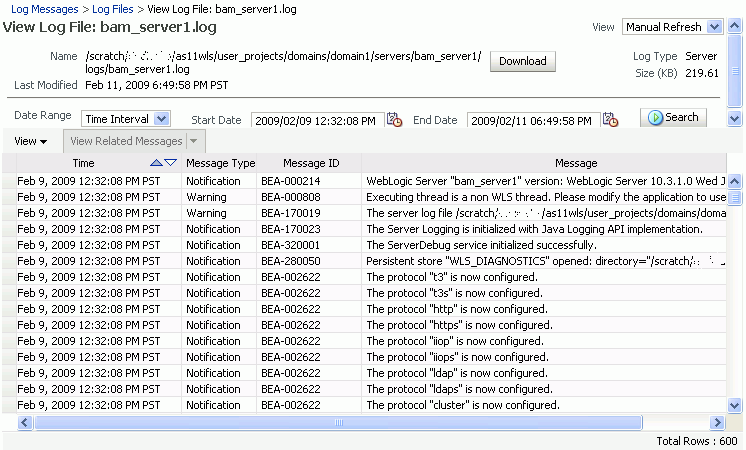22 Monitoring Oracle Business Activity Monitoring
This chapter describes how to view Oracle Business Activity Monitoring (Oracle BAM) performance statistics and logs using Oracle Enterprise Manager Fusion Middleware Control Console.
This chapter includes the following topics:
22.1 Introduction to Monitoring Oracle BAM
You can monitor several aspects of the Oracle BAM components using Oracle Enterprise Manager Fusion Middleware Control Console.
The Oracle BAM Server home page in Fusion Middleware Control Console enables you to monitor each of the Oracle BAM Server Components: Active Data Cache, Event Engine, Report Cache, and Enterprise Message Sources. See Section 22.2, "Monitoring Oracle BAM Server Components" for more information.
The Oracle BAM Web home page in Fusion Middleware Control Console enables you to monitor Oracle BAM Report Server. See Section 22.3, "Monitoring Oracle BAM Web Applications" for more information.
In addition, the Performance Summary pages for each component allow you to track specific statistics of your choosing. See Section 22.5, "Monitoring Oracle BAM Performance" for more information.
Also, you can configure and monitor Oracle BAM logs using Fusion Middleware Control Console. See Section 22.6, "Monitoring Oracle BAM Logs" for more information.
22.2 Monitoring Oracle BAM Server Components
Oracle BAM Server components are monitored on the Fusion Middleware Control Console page for Oracle BAM Server.
To monitor Oracle BAM Server components:
Open Fusion Middleware Control Console in your Web browser at:
http;//host_name:port_number/em
Then, go to the Oracle BAM Server home page by selecting BAM > OracleBamServer in the navigation tree.
In the OracleBamServer page, you can select each tab (Active Data Cache, Event Engine, Report Cache, Enterprise Message Sources) to monitor the individual Oracle BAM Server components.
22.2.1 Monitoring Oracle BAM Active Data Cache
Oracle BAM Active Data Cache (Oracle BAM ADC) is designed and optimized to handle large amounts of data in real time. Data coming into Oracle BAM ADC immediately updates all defined calculations and aggregates in real time in an in-memory cache so that this data can be pushed as quickly as possible to Oracle BAM dashboards and reports. Data fed to the Oracle BAM ADC is received from a combination of sources, from Java Message Service (JMS) topics and queues to more traditional data queries and databases. Oracle BAM ADC ensures that no matter the source, when Oracle BAM Server is aware of the incoming data, it is streamed to Oracle BAM alerts and dashboards as incremental changes.
There are two key components to the Oracle BAM ADC, data sets and viewsets. Oracle BAM ADC receives transactions (insert, update, upsert, delete) into the data sets. These data sets are constructed based on the design that an Oracle BAM developer defines for data relationships when data objects are defined in Oracle BAM Architect. Data objects can be reflective of flat tables of data, or more complex, star-schema relationships between data objects, which are represented in Oracle BAM as data object look-ups.
After data is updated in the data sets, viewsets that are listening on these data sets go into action. The viewsets have knowledge of all of the open Oracle BAM dashboards and alerts that users are viewing in the Oracle BAM system. Viewsets ensure that data updates to these open objects are incrementally updated first, using a push-based mechanism to publish updates to open dashboards and alerts, providing users with the latest information.
Use the Oracle BAM pages in Fusion Middleware Control Console to monitor statistics for all data objects in Oracle BAM ADC as a group, or select a particular data object from the Data Objects list to monitor.
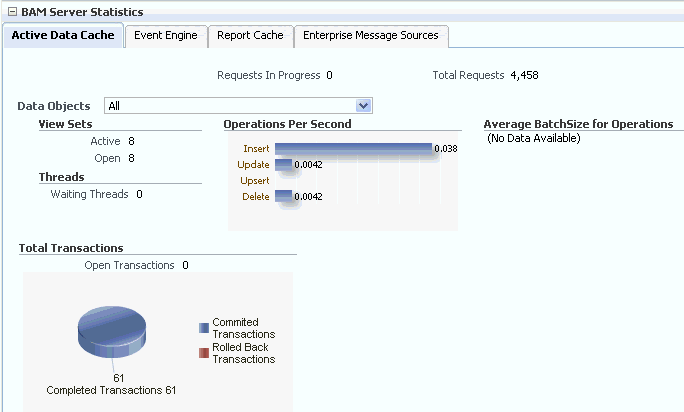
Description of the illustration bam_server_adc_tab.gif
Note:
When you select a data object from the list, cached data is displayed to preserve performance. You must refresh the page (using the Refresh icon) to display the latest data associated with the selected data object.Description of the illustration bam_em_refresh.gif
Active viewsets are those which are typically seen in Oracle BAM reports. Open viewsets are the sum of active and static open viewsets.
Oracle BAM reports and alerts use active viewsets. Oracle BAM Server uses static viewsets for internal process. There are also internal parts of the code that use static viewsets on system objects (metadata tables). It is possible that if Oracle BAM Server is not closing the static viewsets, you observe different values for them.
Static viewsets do not support active data generation and are used to fetch data from data objects, therefore, they are kept open for only a very short time when data is fetched. For that reason, in the Open Viewsets counter, the values appearing most of the time are from active viewsets.
You can monitor the viewset count for Oracle BAM components Active Data Cache, Report Cache, and Report Server. You may see that viewset counts do not match between Active Data Cache, Report Cache, and Report Server metrics.
The Report Server opens viewsets through the Report Cache for all of the views contained in the reports opened in browsers. The Active Data Cache opens more viewsets than the Report Cache. One such viewset opened is in the Active Data Cache through the Event Engine.
Whenever the Event Engine starts, it loads all the defined alerts, and for those alerts that are defined to monitor data changes in the Active Data Cache, corresponding viewsets are opened in the Active Data Cache. That is why more viewsets are displayed in the Active Data Cache monitoring page than on the Report Cache and Report Server pages.
For most of the views in a report, there is a corresponding viewset in the Active Data Cache. Viewsets opened by the report are shared with the subsequent instances of that report, except for Crosstab views. In reports using the Crosstab view, the viewset call is different than the one used by other views. When a report containing a Crosstab view is opened, three viewsets are opened in the Active Data Cache. Two of the viewsets are closed immediately after fetching the data, while one is kept open to monitor the incoming changes.
The Operations Per Second statistic includes all of the insert, update, upsert, and delete operations occurring on the selected data object. The Operations Per Second graph displays statistic for the last 5 minutes.
Average Batch Size for Operations
The Average Batch Size For Operations statistic is the average number of records included in each batch operation on the selected data object. The Average Batch Size for Operations graph displays statistic for the last 5 minutes.
The Threads statistic displays the number of waiting threads in the selected data object.
The Total Transactions statistic displays the number of transactions on Oracle BAM data objects. It is the sum of committed and rolled back transactions. The Total Transactions graph also displays the number of open and completed transactions.
For example, if you add a row in an Oracle BAM data object and save it (commit), it is one transaction. This metric is useful only if the client of Oracle BAM Server is using transactions.
Transactions can also be used by an EMS, when connecting to a JMS topic or queue.
You can configure this metric to track transactions in the Oracle BAM sensor actions in BPEL and in the Oracle Data Integrator knowledge modules.
In regard to Rolled Back Transactions, if an invalid insert operation is attempted on an Oracle BAM data object, Oracle BAM Server rolls back the transaction.
22.2.2 Monitoring the Event Engine Component
The Event Engine is used by Oracle BAM Server to evaluate and execute Oracle BAM alerts. The Event Engine monitors complex data conditions and implements specified rules. Rules can include a series of conditions and actions attached to an event. The Event Engine continuously monitors the information in the Active Data Cache for certain conditions and executes the related actions defined in associated rules.
The Event Engine is responsible for tracking events based on date, time, or data changes. The Event Engine design employs a satellite concept, in which there are four different systems (satellites) within which event clauses can be registered and tracked.
The Date and Time satellites are both based on a scheduler, and they are used for alerts such as "E-mail a snapshot of this Oracle BAM dashboard to me every morning at 8 a.m."
The Manual satellite is use to manually send alerts by name (using a Web service call).
The Data satellite is used to track alerts that are based on specific changes in the data of a given data object, such as "Call this Web service when SUM(Sales) > 10000 in the MediaSales data object," or "Let me know when anything in this dashboard changes."
You can monitor statistics for active Event Engine rules, condition met rates, and processing queues.

Description of the illustration bam_server_eetab.gif
Active Rules displays the number of alert rules that are active (not expired or invalid) in Oracle BAM Event Engine. Active Rules displays the total number of alert rules in Oracle BAM Event Engine, which is the sum of alerts created for all of the Oracle BAM users.
The Rule Fire Rate Per Second group of statistics displays the rates of events over the last 5 minutes for Actual, Events Accepted, and Events Rejected rates.
Actual rule fire rate per second is the number of events fired per second in Event Service. It is the number of events fired per second, taking into account number of times alerts fired events in the previous 5 minutes. For example, if when the OracleBamServer page was loaded, only 2 alerts fired in previous 5 minutes, the value shown would be 2/(5 X 60), that is 0.0067. So, if fired twice in 300 seconds, it would fire 0.0067 times in one second.
Events Accepted is the number of events fired per second from the satellite. That it, the number of events fired per second from alerts configured, that were accepted (for further processing), taking into account events that were accepted in the previous 5 minutes. The value shown is calculated in the same way as Actual. Unless the Event Engine's queue thresholds are exceeded, all events fired are accepted and processed further.
Events Rejected is the number of rejecting events per second. That is, the number of events fired per second from alerts configured, that were rejected (for further processing), taking into account events that were rejected in the previous 5 minutes. The value shown is calculated the same way as Actual. Fired events are rejected when the Event Engine's queue thresholds are exceeded. Ideally this value should be zero.
The Processing Queues Sizes graph displays the size of the event processing queue, that is, the number of events waiting to be processed. These queues are emptied as soon as the events are processed, so there would have to be a large number of events being generated simultaneously to see alerts waiting for processing in the queues.
The Processing Queues Sizes graph displays statistics for the last 5 minutes. The graph displays Rules Fired, Alert Actions and Alerts History Queue health.
Rules Fired Queue displays the number of events that were fired that are waiting to be processed. The Event Engine maintains internal in-memory queue for fired events where all the events are placed temporarily, before being pulled out from here for further processing, as soon as the Event Engine resources are available. This metric shows the number of events fired waiting in queue to be picked by the system.
Alert Actions Queue displays the number of actions waiting to be processed. The Event Engine maintains internal in-memory queue for actions where all the actions are placed temporarily, before being pulled out from here for further processing, as soon as the Event Engine resources are available. This metric shows the number of actions waiting in queue to be picked by the system.
Alerts History Queue displays the number of alert history items to be saved. The Event Engine maintains internal in-memory queue for all history items, where all the items are temporarily placed, and before picking them up to save to back end. This metric shows the number of history items waiting in queue to be picked by the system.
22.2.3 Monitoring the Report Cache Component
The Report Cache assists the Active Data Cache with maintenance of the viewset snapshots in memory. The Report Cache opens viewsets and active viewsets in the Active Data Cache for the Report Server (an Oracle BAM Web applications component). It then caches the snapshot (in small parts) and the active data before sending it to the Report Server. This allows for random access into the snapshot and recovery from losing the connection to Oracle BAM Server. The Report Cache also, along with the Active Data Cache, supports viewset sharing.
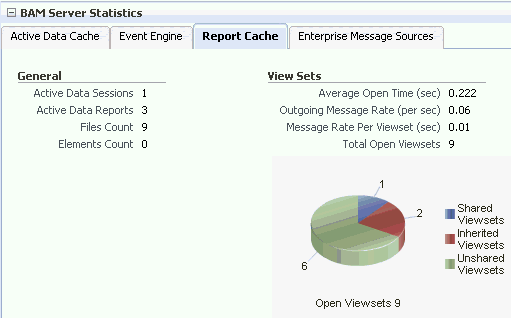
Description of the illustration bam_server_rc_tab.gif
The Active Data Sessions statistic displays the total number of Report Cache sessions with active data.
When a user opens multiple browser windows on a single computer to view Oracle BAM reports, all of the open browser windows share the same Active Data Session. It does not matter whether the user opens the same report or different reports in each browser window, the Active Data Sessions count is always 1.
The Active Data Reports statistic displays the total number of open reports requesting active data.
The Files Count statistic displays the total number of files currently managed by FileBasedPersistenceManager when the Oracle BAM Server is configured to use a file-based persistence manager. See Section 21.3.5, "Configuring Report Cache Persistence Manager" for more information.
The Elements Count statistic displays the total number of elements currently managed by InMemoryPersistenceManager when the Oracle BAM Server is configured to use a memory-based persistence manager. See Section 21.3.5, "Configuring Report Cache Persistence Manager" for more information.
The Viewsets group of statistics displays the following counters:
Average Open Time (sec) is the average time taken to open a viewset.
Outgoing Message Rate (per sec) is the number of change lists delivered per second by Report Cache to all of its clients.
Message Rate Per Viewset (sec) the number of change lists delivered per second per viewset.
Total Open Viewsets is the total number of viewsets (that is, the sum of shared, unshared, and inherited viewsets) maintained in Report Cache for all of the views contained in the reports opened in browsers.
The Open Viewsets graph displays shared, inherited, and unshared viewsets.
Shared Viewsets are the parent viewsets (these are the viewsets that are opened first).
Inherited Viewsets are the child viewsets (these viewsets are opened later).
Unshared Viewsets (independent viewsets) are neither shared or inherited.
Viewset sharing occurs whenever possible for performance reasons (the consumers require the exact same viewsets, so the viewsets can be shared). If the viewsets cannot be shared, they are unshared.
When users who do not have any differences in row-level security open the same report at close to the same time, the viewsets that are created for them in the Active Data Cache are shared in the Report Cache.
Note:
Viewset counts may not match between Active Data Cache, Report Cache, and Report Server metrics. See "Viewset Count Variation" for more information.22.2.4 Monitoring the Enterprise Message Sources
Enterprise Message Sources (EMS) are used by applications to provide direct Java Message Service (JMS) connectivity to Oracle BAM Server by mapping messages directly to Oracle BAM data objects. Oracle BAM Server can read data directly from any JMS-based message queue or topic. This option offers guaranteed messaging. It is more difficult to configure and not as fast to perform rigorous data transformations in XML Stylesheet Language (XSL) than in an Extract Transform and Load (ETL) tool like Oracle Data Integrator.
The EMS feature does not configure ETL scenarios, but rather maps from a message directly to a data object on Oracle BAM Server; however, you can still use XSL transformations before the data is inserted (updated, upserted, or deleted) into the data object. Each EMS reads from a specific JMS topic or queue, and the information is delivered into a data object in the Active Data Cache. The Oracle BAM Architect Web application is used to configure EMS definitions.
For more information about configuring EMS definitions, see Oracle Fusion Middleware Developer's Guide for Oracle SOA Suite.
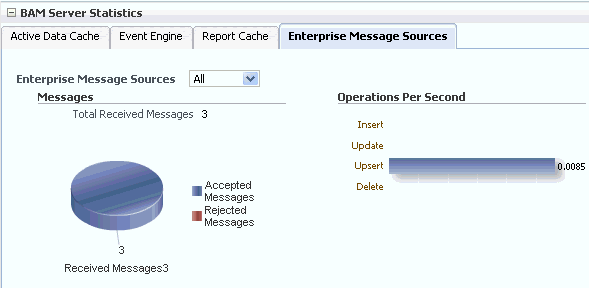
Description of the illustration bam_server_ems_tab.gif
Note:
Data is displayed in the Enterprise Message Source tab only when EMS definitions are created and started in Oracle BAM Architect. Fusion Middleware Control Console may take some time to fetch the data and display the statistic in the Enterprise Message Source tab.Refreshing the page displays the latest EMS data. You can refresh the page using the Refresh icon.
Description of the illustration bam_em_refresh.gif
Select the EMS to monitor. You can choose to display aggregated statistics for all EMS definitions, or select a particular EMS to monitor from the list provided.
Monitor the number of messages received by the selected EMS. You can find rejection statistics in the Performance Summary metrics page.
The Messages graph displays the number of Received Messages broken down into Accepted Messages and Rejected Messages, and at the top of the graph the number of Total Received Messages is displayed.
Monitor the rate of insert, update, upsert, and delete operations performed by the selected EMS.
The Operations Per Second graph displays statistic for last 5 minutes.
For more granular detail about the rates for each type of operation, go to the Performance Summary page. See Section 22.5, "Monitoring Oracle BAM Performance" for more information.
22.2.5 Monitoring the Client Requests in Progress
The Oracle BAM Client Requests in Progress chart is displayed in the lower right corner of the Oracle BAM Server home page. Client requests include all of the requests made to the Oracle BAM Server Enterprise Java Beans (EJB).
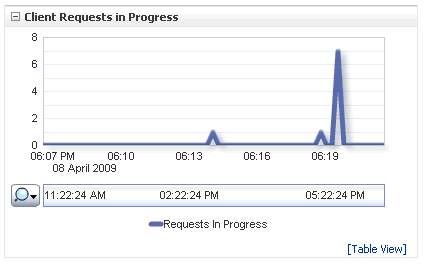
Description of the illustration bam_em_server_chart.gif
There are a lot of internal requests made when opening a single report (for permissions, the report metadata, the views data, and so on); however, the user may or may not see those internal requests displayed in this chart.
22.3 Monitoring Oracle BAM Web Applications
Oracle BAM Web applications are monitored in the Oracle BAM Web page of Fusion Middleware Control Console.
To monitor Oracle BAM Report Server go to the Oracle BAM Web home page by selecting BAM > OracleBamWeb in the navigation tree.
22.3.1 Monitoring Oracle BAM Report Server
Oracle BAM Report Server applies the report definitions to the data sets retrieved from the Oracle BAM ADC for presentation in a browser. It manages information paging for viewing and printing reports. After reports are created, they are stored in the Oracle BAM ADC so that report creation is not repeated each time. Most reporting views are designed to support live, active displays of data changing in real time.
You can monitor statistics for Oracle BAM Report Server connections, viewsets, and reports.

Description of the illustration bam_web_reportserver.gif
The Connections statistics display the following:
Open Connections is the number of connections open on the Report Server. An open connection corresponds to each user per session. It is different from the number of reports opened, because one user could at most have one connection open at a time regardless of how many reports the user has opened.
Message Rate (per sec) is the total number of messages (viewset change lists) delivered per second to all users (connections).
Message Rate Per Connection (sec) is the number of messages (viewset change lists) delivered per second per user (connection).
The Viewsets statistics display the number of open viewsets (Open), and the average amount of time (in seconds) that the viewsets are open (Average Open Time (sec)).
Note:
Viewset counts may not match between Active Data Cache, Report Cache, and Report Server metrics. See "Viewset Count Variation" for more information.The Report statistic displays the total number of open reports. The Open Connections graph displays open connections to Oracle BAM Web applications. You can use the zoom axis to zoom in on a particular time in which you are interested to see the open connections statistic.
The total number of reports includes the count of duplicate reports opened by the same user. Even if the same report is opened in multiple browser windows, each instance is considered a separate report, because a new viewset is opened in Report Server (through Oracle BAM Report Cache) for each report instance, though the viewsets are shared.
22.3.2 Monitoring Open Connections
The Oracle BAM Open Connections chart is displayed in the lower right corner of the Oracle BAM Server home page.
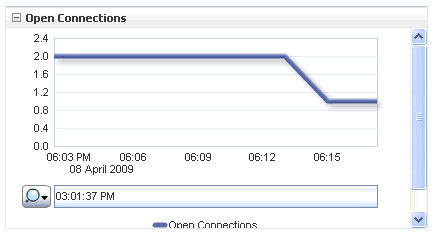
Description of the illustration bam_web_openconngraph.gif
22.4 Monitoring Oracle BAM Web Services
Oracle BAM Web services details are not listed in the Oracle BAM home pages. Oracle BAM Web services counters are available by selecting WebLogic Domain > soa_bam_domain > bam_server1 in the navigation tree, and selecting the JEE Web Services tab in the Most Requested region as shown in Figure 22-2.
Oracle BAM provides DataObjectDefinition, DataObjectOperationsByName, DataObjectOperationsByID, DataObjectOperations10131, ManualRuleFire, and ICommand Web services. See "Using Oracle BAM Web Services" in Oracle Fusion Middleware Developer's Guide for Oracle SOA Suite
You can see the following statistics in JEE Web Services table: Invocation Count, Response Count, Response Error Count, Average Response Time (ms), Average Execution Time (ms), and Dispatch Time Total.
Figure 22-2 Oracle BAM Web Services Counters
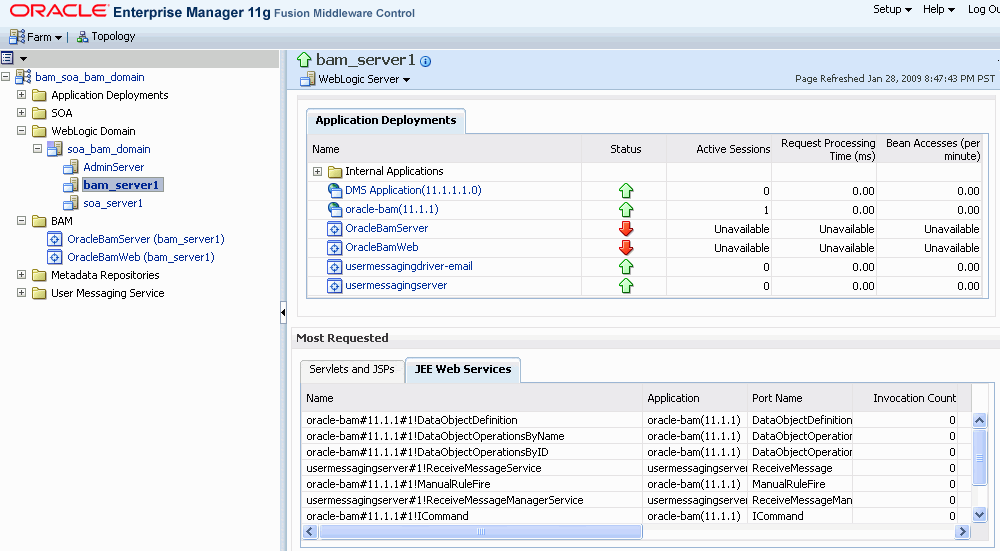
Description of "Figure 22-2 Oracle BAM Web Services Counters"
22.5 Monitoring Oracle BAM Performance
The performance of Oracle BAM applications is reflected in metrics and statistics. There are separate Performance Summary pages with appropriate metrics for Oracle BAM Server and Oracle BAM Web applications.
When you select the Monitoring > Performance Summary menu item in each of the Oracle BAM component menus (as shown in Figure 22-3), the Performance Summary page appears as shown in Figure 22-4.
Many metrics are available for capture and display (most of which are also displayed in the Oracle BAM component home pages). Descriptions of each metric are available in the metrics help pages.
To get the most valuable, focused information, use the Metric Palette. Click Show Metric Palette to display the Metric Palette, shown in Figure 22-5.
Choose the metrics in which you are most interested. As you select or deselect metrics from the palette, the metrics graph at the left is updated automatically.
Figure 22-5 Metric Palette for Oracle BAM Web Applications
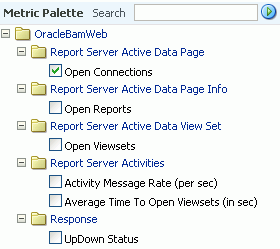
Description of "Figure 22-5 Metric Palette for Oracle BAM Web Applications"
Right click the metric label and select Help, as shown in Figure 22-6, to find more information about each of the metrics.
22.6 Monitoring Oracle BAM Logs
Oracle BAM logs are configured and viewed using Fusion Middleware Control Console.
Note:
Despite having separate log pages for Oracle BAM Server and Oracle BAM Web applications, each page displays the logs for all Oracle BAM application components.For information about using the logger features see the online Help page. For information about configuring the logger, see Section 21.4, "Configuring the Logger."
To view the logs, right click the OracleBamServer node or OracleBamWeb node in the navigation tree and select Logs > View Log Messages as shown in Figure 22-7.
The log viewer page opens as shown in Figure 22-8. Use this page to query for information about the component. Fields and lists are used to customize the query.
After entering your search criteria, click Target Log Files. The Log Files page appears as shown in Figure 22-9. You can view specific log information (shown in Figure 22-10) or download the log.
